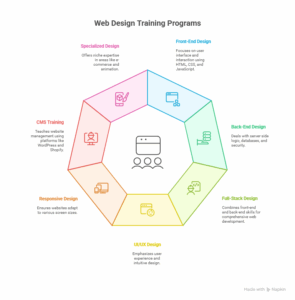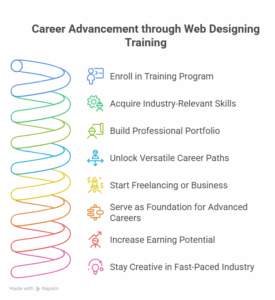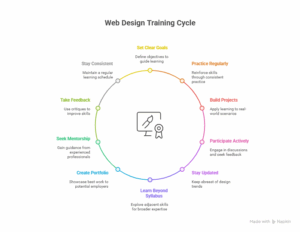In a world where first impressions are often made online, the importance of well-designed, user-friendly websites has never been greater. From small businesses to global enterprises, everyone relies on digital presence to connect with their audience—and at the heart of that presence is great web design.
Web Designing Training empowers you with the creative and technical skills needed to design websites that are not only visually appealing but also intuitive, responsive, and high-performing. Whether you’re a student exploring future-ready careers, a working professional seeking new opportunities, or an entrepreneur building your own brand, learning web design opens doors to limitless possibilities in the digital space.
In this comprehensive guide, we’ll explore everything you need to know about Web Designing Training: why it’s essential, the different types of training programs available, how it can boost your career, and tips to get the most out of your learning journey. By the end, you’ll understand how web design is more than just aesthetics—it’s a strategic career choice in today’s technology-driven world.
Why Choose Web Designing Training?
In today’s digital-first world, websites are essential for every business, brand, and individual. Web Designing Training equips you with the creative and technical skills needed to build visually appealing, user-friendly websites that perform well across devices. With demand for web designers growing rapidly across industries, this training opens doors to high-paying jobs, freelancing opportunities, and even entrepreneurship.
Whether you’re a student aiming for a future-proof career or a professional looking to reskill, Web Designing Training offers a perfect blend of creativity, coding, and career flexibility—making it one of the smartest investments for your future.
Top 7 Types of Web Designing Training Programs

When exploring your options for Web Designing Training, it’s important to understand the different types of programs available. Each training type caters to a specific set of skills and career objectives—whether you’re looking to design interfaces, develop entire websites, or specialize in a niche area. Here’s a detailed breakdown of the most in-demand Web Designing Training categories:
1. Front-End Web Designing Training
Front-end web designing focuses on everything the user sees and interacts with on a website. This includes layout, typography, colors, buttons, menus, and animation effects. In this Web Designing Training program, you’ll learn essential coding languages like:
-
HTML (for structuring content)
-
CSS (for styling elements)
-
JavaScript (for interactivity)
Modern frameworks such as React, Vue.js, or Bootstrap are also introduced to enhance responsiveness and development speed. This training is ideal for creative individuals who enjoy working on visuals and user experiences.
2. Back-End Web Designing Training
Back-end training dives into the server side of web development—responsible for databases, logic, security, and performance. You’ll work with technologies such as:
-
PHP, Python, Node.js, or Ruby for server-side scripting
-
MySQL, MongoDB, or PostgreSQL for database management
-
REST APIs for dynamic data handling
If you’re technically inclined and want to understand how websites function behind the scenes, this type of Web Designing Training is an excellent choice. It’s particularly useful for those interested in developing custom functionalities, content management systems, or scalable applications.
3. Full-Stack Web Designing Training
A full-stack web designer/developer is proficient in both front-end and back-end technologies. This all-in-one Web Designing Training program provides comprehensive knowledge of:
-
Client-side technologies (HTML, CSS, JS, frameworks)
-
Server-side development (Node.js, PHP, databases)
-
Deployment strategies, version control (Git/GitHub), and debugging tools
Full-stack training is best for professionals who want to manage end-to-end web projects, lead development teams, or launch their own web-based startups. The broad skill set also opens doors to higher-paying roles.
4. UI/UX Design Training
User Interface (UI) and User Experience (UX) design are key to creating intuitive, attractive websites. This form of Web Designing Training focuses on:
-
User research and persona development
-
Prototyping and wireframing with programs like Adobe XD or Figma
-
Usability testing and feedback loops
-
Design psychology, color theory, and accessibility
This training is perfect for those with a keen eye for design and a passion for solving real user problems. It enhances your ability to design not just websites, but apps and digital platforms that people love to use.
5. Responsive and Mobile Web Design Training
Today’s users access websites on desktops, tablets, and smartphones. This specialized Web Designing Training teaches you how to create designs that adapt seamlessly to any screen size. You’ll learn:
-
CSS media queries and flexible grids
-
Mobile-first design principles
-
Cross-browser compatibility techniques
-
Performance optimization for mobile users
This training is vital for designers and developers aiming to build modern websites that function well across devices, ensuring better user engagement and SEO performance.
6. CMS and Website Builder Training
This program is designed for those who want to build and manage websites using Content Management Systems (CMS) or drag-and-drop website builders. Key platforms include:
-
WordPress (most widely used CMS)
-
Shopify (ideal for e-commerce)
-
Joomla, Wix, and Squarespace
In this Web Designing Training, you’ll learn how to install themes, use plugins, manage content, set up online stores, and handle basic SEO settings. It’s perfect for beginners, small business owners, marketers, and freelancers who want to launch professional websites without diving deep into code.
7. Specialized Web Designing Training (E-commerce, Animation, Portfolios)
Some learners prefer niche expertise. Specialized Web Designing Training programs are tailored for advanced learners or professionals who want to focus on specific areas such as:
-
E-Commerce Design: Building online stores using WooCommerce, Shopify, Magento
-
Animation and Interactivity: Using Adobe Animate, LottieFiles, or GreenSock for motion graphics and scroll-based animations
-
Portfolio & Brand Websites: Personal websites with custom layouts, typography, and performance optimization
These programs often blend multiple tools and skills to provide focused, job-ready expertise for high-demand sectors or personal branding.
How Web Designing Training Boosts Your Career

For companies of all sizes, having a strong online presence is essential in today’s digitally first world. As a result, the demand for skilled web designers is rapidly increasing. Enrolling in a Web Designing Training program can be a transformative step toward a promising career in the IT and design industry. Here’s how it can significantly impact your professional journey:
Learn Industry-Relevant Skills
Web designing training programs provide hands-on experience with essential tools and technologies such as HTML, CSS, JavaScript, Bootstrap, and responsive design principles. In addition, you’ll become proficient with design software like Adobe XD, Figma, and Photoshop. These are core skills that companies actively look for when hiring web professionals.
Build a Professional Portfolio
A strong portfolio is often more important than a resume in creative fields like web design. Training programs typically include project-based learning, enabling you to create live websites, landing pages, UI designs, and interactive layouts. This real-world experience builds your confidence and gives you tangible proof of your skills when applying for jobs or freelance work.
Unlock Versatile Career Paths
Completing a comprehensive Web Designing Training course opens the door to various roles such as Web Designer, Front-End Developer, UI/UX Designer, WordPress Developer, and Design Consultant. These roles are available in a wide range of industries including e-commerce, digital marketing, education, media, healthcare, and finance.
Start Freelancing or Your Own Business
One of the biggest advantages of web designing is its entrepreneurial potential. Once equipped with the right skills, you can begin freelancing on platforms like Upwork, Freelancer, and Fiverr. You can also start your own design agency, offering services such as website development, redesign, and branding for local or global clients.
Serve as a Foundation for Advanced Careers
Web designing can be a starting point for other advanced careers in tech. Many professionals use it as a foundation to learn full-stack development, mobile app design, game design, or digital marketing. The design thinking and problem-solving skills you develop will remain valuable as you advance into more specialized areas.
Increase Your Earning Potential
Well-trained web designers enjoy strong salary packages, especially when paired with a solid portfolio and a good understanding of user experience. As you gain more experience and take on larger projects or managerial roles, your earning potential can increase significantly. In freelance work, you can scale your income based on the number and size of projects you handle.
Stay Creative in a Fast-Paced Industry
Web designing is ideal for those who enjoy creativity and problem-solving. The industry is constantly evolving, with new design trends, technologies, and frameworks emerging regularly. This continuous innovation ensures that your job remains dynamic and intellectually engaging, avoiding monotony and promoting personal growth.
Key Features of the Best Web Designing Training Courses
Choosing the right Web Designing Training course is crucial for building a solid foundation and advancing your career. The best programs are designed not only to teach you technical skills but also to prepare you for real-world challenges. Below are the key features you should look for in a high-quality web designing course:
1. Industry-Aligned Curriculum
Top courses offer a syllabus that aligns with current industry demands. They cover all essential topics including HTML5, CSS3, JavaScript, Bootstrap, responsive design, UI/UX principles, and basic SEO practices. Some also include training on design tools like Figma, Adobe XD, and Photoshop.
2. Hands-On Training with Real Projects
Effective training involves practical experience. The best courses provide real-time projects where students create websites, landing pages, and user interfaces. This hands-on exposure helps learners understand how to apply their knowledge in actual work scenarios.
3. Experienced Trainers
A course led by industry professionals or certified instructors ensures high-quality teaching. Trainers with real-world experience can offer valuable insights, share best practices, and provide personalized feedback to help you improve.
4. Career Support and Placement Assistance
Reputed institutes offer career development support, including resume building, portfolio reviews, interview preparation, and placement opportunities. Some even have tie-ups with companies to facilitate job placements after course completion.
5. Flexible Learning Options
The best web designing courses cater to diverse learners by offering both online and offline training options. Weekend batches, recorded sessions, and self-paced modules make it convenient for working professionals and students to learn at their own pace.
6. Certification and Recognition
A course that provides a valid certificate from a recognized institution adds credibility to your profile. Certifications not only showcase your knowledge but also enhance your chances of being shortlisted by employers or freelance clients.
7. Post-Course Support and Resources
After completing the training, ongoing support can be crucial. Leading institutes offer lifetime access to course materials, updated content, and post-course mentoring to help learners keep up with industry changes and continue learning.
Tips for Maximizing Your Web Designing Training Experience

Enrolling in a Web Designing Training course is a strategic step toward a creative and in-demand career. However, to truly benefit from the program, active engagement and smart learning strategies are essential. Here are proven tips to help you make the most of your training experience:
1. Set Clear Learning Goals
Before you begin, outline your goals—whether it’s to become a front-end developer, freelance designer, or UI/UX specialist. This clarity will help you stay focused and choose relevant projects during your course.
2. Practice Regularly
Web design is a practical skill. Set aside time every day or every week to put what you’ve learned into practice. Experiment with layouts, color schemes, and coding structures using tools like HTML, CSS, and JavaScript to reinforce your knowledge.
3. Build Real-World Projects
Apply your learning by creating real or sample projects such as portfolio websites, blogs, or e-commerce mockups. These hands-on experiences are crucial for gaining confidence and building a strong portfolio.
4. Participate Actively in Class
Interact with your peers and trainers both in person and virtually. Ask questions, join discussions, and seek feedback. Active participation enhances your understanding and improves your problem-solving skills.
5. Stay Updated with Design Trends
Web design evolves rapidly. Follow design blogs, YouTube channels, and forums like Behance, Dribbble, and Stack Overflow to keep up with the latest tools, frameworks, and best practices.
6. Learn Beyond the Syllabus
Go beyond your course material by exploring adjacent skills such as graphic design, animation, SEO, and website accessibility. These added capabilities make you a well-rounded designer and more competitive in the job market.
7. Create and Maintain a Portfolio
Document your best work during training and publish it on platforms like GitHub or your personal website. A strong portfolio is often more impactful than a resume in creative fields like web design.
8. Seek Mentorship and Peer Support
Make contact with professors, former students, or business leaders for direction and career assistance. Peer groups and online communities can also offer support, code reviews, and collaboration opportunities.
9. Take Feedback Constructively
Don’t hesitate to share your work and receive critiques. Constructive feedback helps refine your design sense, coding habits, and presentation skills.
10. Stay Consistent and Committed
Consistency is key to mastering web design. Stick to a regular learning schedule, meet assignment deadlines, and keep pushing your limits to see consistent improvement.
Frequently Asked Questions About Web Designing Training
Considering web designing training as your next move? Here are some of the most common questions prospective students have, with clear answers to help you make the right decision for your career.
What is web designing training?
Web designing training is a professional course that teaches you how to plan, design, develop, and maintain modern, user-friendly websites. It covers both the aesthetic aspects (like layouts, colors, and graphics) and the technical skills (coding with HTML, CSS, JavaScript, etc.) required to build functional, responsive sites.
Who can join a web designing training program?
Anyone with basic computer skills and an interest in technology or creativity can enroll—no prior coding or design experience required. Training is suitable for students, job-seekers, working professionals looking to reskill, freelancers, entrepreneurs, and even hobbyists wanting to design personal websites.
What skills will I learn in web designing training?
You’ll gain hands-on knowledge in:
-
HTML, CSS, and JavaScript for building web pages
-
Responsive and mobile-first design techniques
-
UI/UX (User Interface and User Experience) principles
-
Using design software such as Illustrator, Photoshop, Sketch, or Figma
-
Working with Content Management Systems (CMS) like WordPress or Shopify
-
Search Engine Optimization (SEO) basics for web design
-
Portfolio and project development
Is web designing training only about coding?
No, web designing combines both creative and technical skills. You’ll learn visual design, user experience (UX), branding, color theory, and typography alongside coding and software tools. It’s a well-rounded program for creative thinkers and logical problem solvers alike.
Does becoming a web designer require a degree?
No degree is necessary. Many successful web designers have built their careers through targeted web designing training and self-developed portfolios. Employers pay more attention to your skills, project work, and portfolio than to your educational background.
What kind of job can I get after completing web designing training?
Graduates can pursue roles such as:
-
Web Designer
-
Front-End Developer
-
UI/UX Designer
-
WordPress Developer
-
Web Content Manager
-
Freelance Web Designer
You can work for tech companies, digital agencies, startups, large enterprises, or as an independent freelancer.
How long does it take to complete web designing training?
Course length varies by provider and depth of learning. Short bootcamps can last a few weeks to a couple of months, while comprehensive diplomas or advanced certifications may take 3–12 months. Flexible, self-paced online options are widely available.
Conclusion: Your Pathway to Success in Web Designing
Embarking on a journey with web designing training is a pivotal step toward a creative, future-proof career. The digital world is expanding relentlessly, and those who can create outstanding, user-focused websites are at the heart of this transformation. By choosing a modern web designing training program, you equip yourself with versatile technical, visual, and strategic skills that open doors to countless opportunities.
Whether you aim to join a top tech company, thrive as a freelancer, or launch your own projects, comprehensive web designing training gives you more than just the technical know-how—it instills confidence, nurtures creative thinking, and fosters continuous adaptation in a fast-changing field. With hands-on practice, real-world projects, and guidance from expert mentors, you’ll graduate with a portfolio that turns heads and skills that remain in demand regardless of industry changes.
Remember, success in web design isn’t just about learning code or design principles—it’s about building a mindset of problem-solving, curiosity, and user empathy. Pair your web designing training with a strong portfolio, a commitment to ongoing learning, and active engagement in the design community.
Your pathway to success starts the moment you invest in high-quality web designing training—and every project, challenge, or client you take on from there will only accelerate your growth. Step confidently into the digital world, knowing you have the tools and knowledge to shape remarkable online experiences and build the flexible, rewarding career you deserve.












